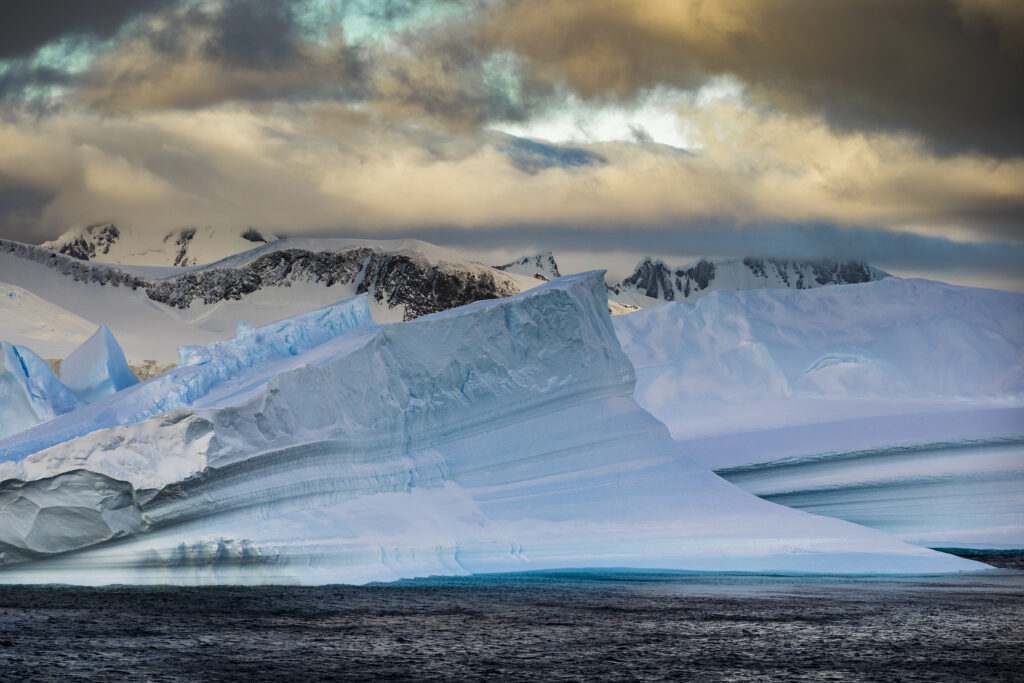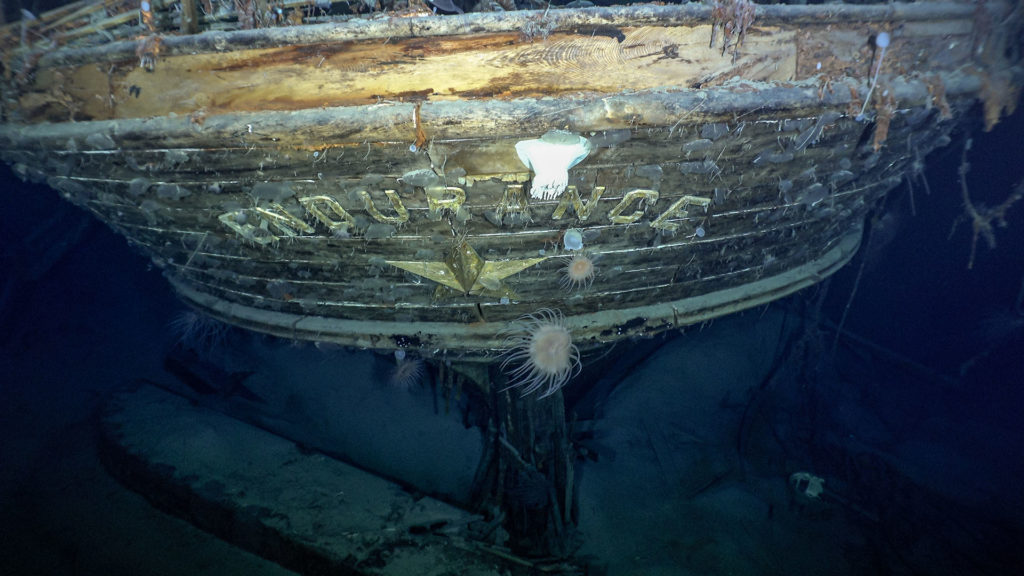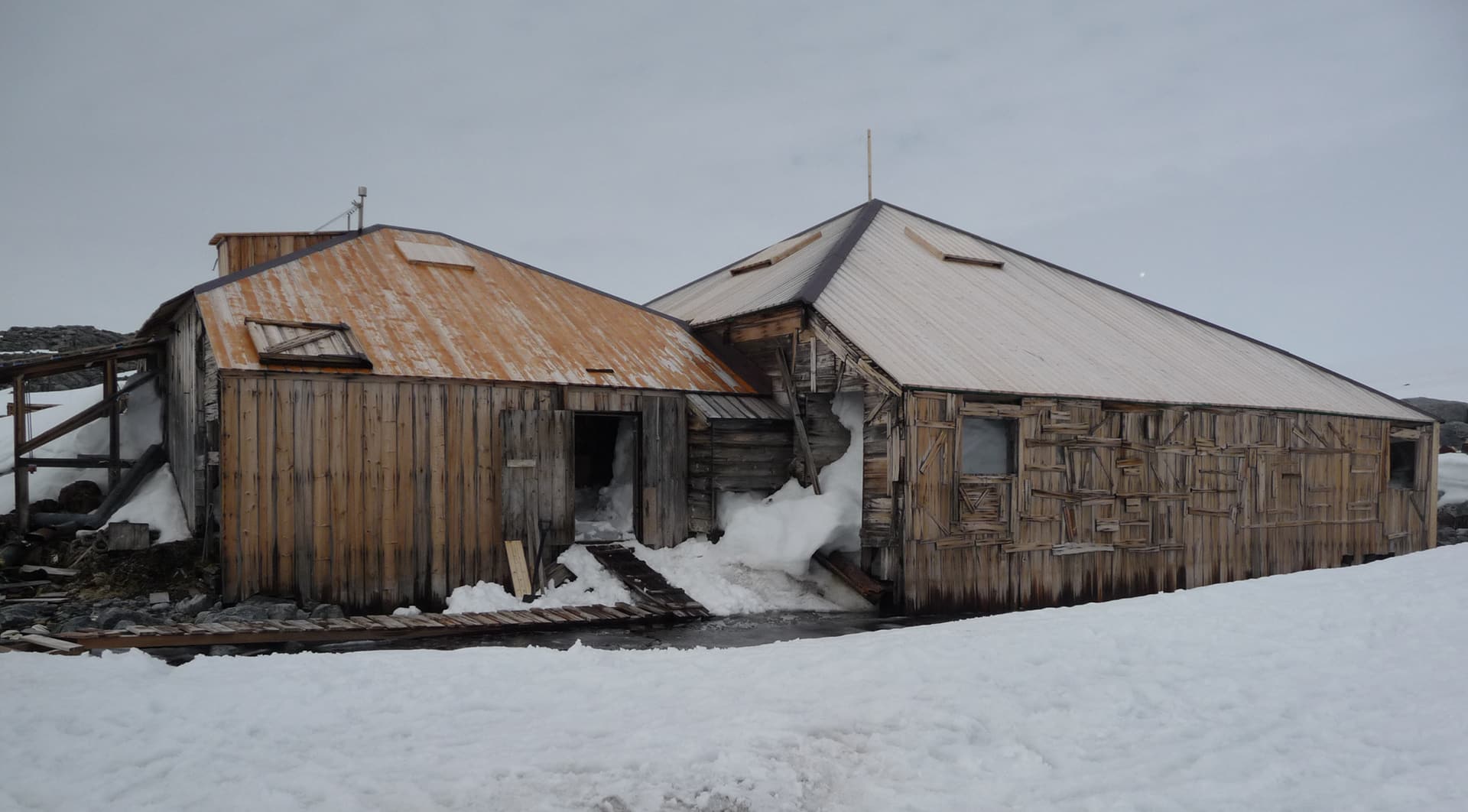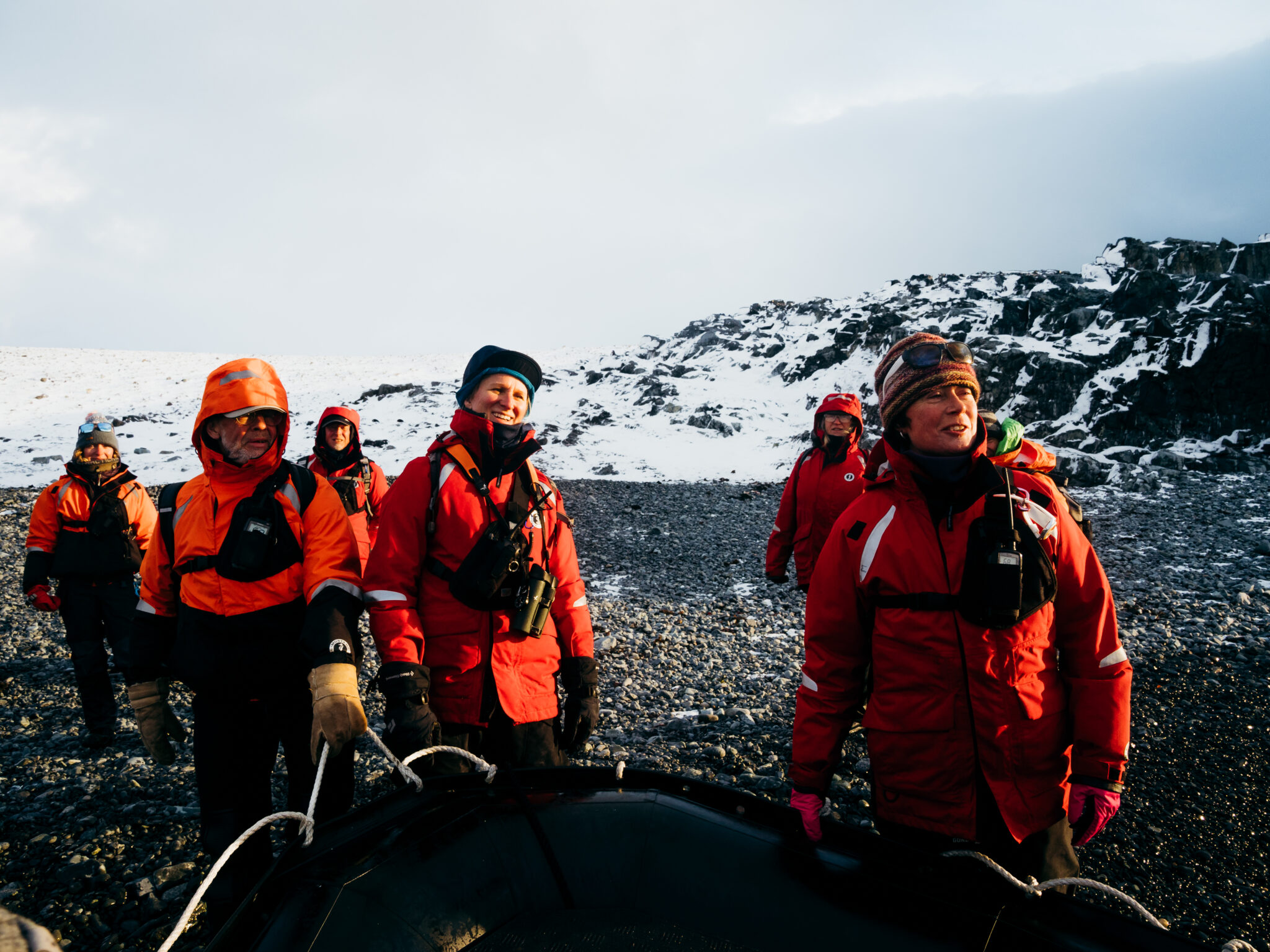Few places on Earth capture the imagination like Antarctica. The world’s last frontier, it eluded the flag-in-ground race of person or nation until the turn of the 20th century. From 1897 to 1922, dramatically called the Heroic Age of Antarctic Exploration, eight countries launched 16 major expeditions. These daring missions were not without tragedy.
As you read about the most famous explorers in Antarctica, you’ll discover tales of ships stranded, starvation and lives lost. And yet these outlandish stories demonstrate the sheer strength and capacity of the human spirit in times of adversity. An inspiration as much as a warning cry.
These key figures have left a legacy of hand-drawn maps, scientific research and geographic exploration, that has shaped our world today. Their efforts led to the Antarctica Treaty, uniting nations to best protect and preserve Antarctica.
In preparation for your own polar expedition, read about top Antarctica explorers and their daring tales of tenacity and ingenuity.

Sir Robert Falcon Scott (1868-1912)
Robert Falcon Scott is one of the most prominent figures in the Antarctic golden age. This is thanks to his unwavering determination to embark on not one but two ambitious expeditions to Antarctica’s icy abyss.
After leading a successful Royal Navy career, Devon-born Scott coupled his passion for adventure with his naval experience. His first expedition in 1901, the Discovery Expedition, saw Scott and his crew sail to Antarctica’s frozen expanse on a three-year expedition that was widely acclaimed – not just because of the first sighting of emperor penguins.
The result of Sir Robert Falcon Scott’s first sailing set the groundwork for a second attempt. In 1910, the tragic Terra Nova Expedition launched with the goal of being the first to reach the South Pole. Brutal weather, restricted resources, and the physical strains of the environment saw them reach the South Pole in 1912. They soon learnt, however, that Roald Amundsen had beaten them 34 days earlier.
Tragically, Scott and his team did not leave the continent, with hypothermia taking their lives on their return from the South Pole. They were sadly only 17 kilometres (11 miles) from help. Journals found with their bodies revealed the hardships they endured, which have provided endless inspiration for generations of adventurers.
Roald Amundsen (1872-1928)
While it was an accolade desired by so many, Norwegian explorer Roald Amundsen was the first to reach the South Pole. That was not his only first; he also was the first to cross Canada’s Northwest Passage and reach the North Pole. He then led a successful North Pole air expedition in 1926.
Given Norway’s position close to the North Pole, it’s understandable why Amundsen’s fascination with the polar regions was ignited at an early age. After inspiration from the famous explorers before him, he became a seaman, learning to navigate, sail and survive extreme conditions. From 1897 to 1899, he undertook his first polar expedition aboard the Belgian Antarctic Expedition. The Belgica was the first ever documented ship trapped by overwintering in Antarctica.
In 1910, Roald Amundsen set sail on the two-year South Pole Expedition which resulted in his most significant feat: being the first to conquer the South Pole! It is a credit to Amundsen’s meticulous planning (kept top-secret), efficiency and foresight to study Inuit survival techniques, that saw him beat his competitors to the South Pole by just over a month.
While Amundsen’s life was tragically cut short in 1928 when he disappeared during an explorer rescue mission, his legacy lives on. His ground-breaking achievements and relentless quest for discovery have inspired thousands of global travellers to explore the fascinating polar regions.
Sir Ernest Shackleton (1874-1922)
Antarctic explorer Ernest Shackleton is arguably the most legendary Antarctic explorer. Irish-born, Shackleton led several British expeditions to the region. This includes his ill-fated Endurance endeavour, where stories of courage, leadership and unimaginable hardships saw him start as an explorer and return a hero.
Shackleton experienced his first taste of Antarctic quests when he joined Robert Falcon Scott in 1901 on the Discovery. A grave illness saw Shackleton return early, but his experience proved valuable and his quest to return strong.
In 1914, Ernest Shackleton and his crew set sail to Antarctica with the goal of crossing from one coast to the other via the South Pole. En route, the Endurance became stranded by pack and sea ice and slowly crushed in one of the most hostile places on Earth. Remarkably, an Antarctic robot explorer discovered the wreckage in the Weddell Sea in 2022!
Aboard the Endurance, Shackleton and his crew weathered the harsh conditions and limited rations for months. After their ship became useless, they lived on floating ice for five months until the 28 members of the expedition finally escaped in three small boats to Elephant Island in the South Shetland Islands. Shackleton and five men set out in lifeboats on an incredibly daring 14-day 1,300-kilometre (800-mile) ocean journey to the Southern South Georgia Island. They received assistance at a whaling station and after four attempts, they successfully rescued the remaining Endurance men in 1916.
Shackleton’s interminable-seeming struggles made him a cult figure in the Antarctica history books – one of the greats. Without his leadership and single-minded determination, it’s unlikely that the story would have ended as it did, without a single life lost.
Find out more about why Shackleton’s 100 year legacy lives on. Keen to follow in his footsteps? Since 2001, we’ve offered intrepid hikers the chance to hike the Shackleton crossing by foot!

Sir James Clark Ross (1800-1862)
British naval officer and explorer James Clark Ross is another explorer lauded in the Antarctic history books. Undertaking several challenging expeditions to the world’s iciest continent, Ross drew inspiration as an explorer from a long family line of naval officers. His uncle, John Ross, was a well-known Arctic explorer.
After two successful expeditions aboard HMS Erebus and HMS Terror, Ross gained valuable skills and an aptitude for Antarctica’s wild conditions. His prime mission: to explore the vast, uncharted regions of the Southern Ocean and Antarctica.
On his 1839-1843 expedition, Ross fulfilled this mission, reaching further south than anyone on record. He discovered the Ross Sea and Ross Ice Shelf. As one of the world’s largest and deepest bays, Ross’s meticulous work in the Ross Sea added valuable details to the region’s southern coastline. It laid the foundation for future Antarctica explorers. Ross’s extensive survey work in the Ross Sea also included the discovery of two volcanic islands, including the southernmost on Earth, Mount Erebus.
In 1839, Ross led the Magnetic Pole Expedition, another leap in our geographic understanding of the Antarctic Peninsula and scientific progress, too. After arduous treks across the icy terrain, Ross and his crew identified the approximate location of the South Pole. This was a boon in advancing geomagnetism, the study of Earth’s magnetic field.
Another impressive legacy that Sir James Clark Ross left relates to the importance of wildlife conservation in Antarctica. Alongside discouraging hunting and poaching, Ross recognised the ecological significance of the region’s fauna. It is a legacy that we are proud to uphold as part of our Sustainability in Action initiatives.
Sir Douglas Mawson (1882-1958)
Australia’s most famous Antarctic explorer during the Heroic Age, Douglas Mawson was the first person to set foot in Antarctica’s Commonwealth Bay region – Australia’s gateway to the White Continent.
Born in England, Mawson emigrated to Australia at a young age and pursued his interests in geology and exploration with a fevered passion. Opportunities to study and conduct scientific research in Antarctica opened his mind to expedition life.
Mawson (thankfully) turned down an invite from Robert Falcon Scott to join his calamitous Terra Nova Expedition. In 1907, Mawson joined Ernest Shackleton on his Nimrod Expedition, instead. It was here Mawson led the Far Eastern Party to survey and explore King Edward VII Land. This resulted in the discovery of new Antarctic territory. It was not enough, however, to sate Mawson’s thirst for adventure: he wanted to explore East Antarctica, south of Australia.
In 1911, Sir Douglas Mawson headed south as head of the Australasian Antarctic Expedition aboard the Aurora – our namesake. At the time, the huge expanse of East Antarctica was wholly unexplored, affording Mawson and his 30-strong team (stationed at three bases) a wealth of material to discover. Focusing on the region’s geology, meteorology, biology and auroral research, their results contributed to new land discoveries, detailed maps, glaciological intel, biological documentation and specimen collection of Antarctica’s marine and land animals.
As you know by now, Antarctica is a hostile environment filled with perils and perishment. Mawson’s gruelling Far Eastern Party 1912 side trip pushed him to his limits. While he wasn’t shy of danger, on this crushing mission, Mawson suffered impenetrable blizzards, a fateful crevasse fall, supply issues and lives lost. It ended with him enduring a solo ordeal to rejoin the rest of the Australasian Antarctic Expedition.
While his journey to survive reads like fiction, Mawson’s resilience, leadership and survival skills saw him beat the odds and return to Australia to share the group’s important scientific findings.
Read more about the legacy of Mawson at Mawson’s Hut.

Sir Edmund Hillary (1919-2008)
While you may know Edmund Hillary as the first man to summit Mount Everest with Nepalese Tenzing Norgay, he was also a polar explorer. Hillary was the third man to reach the South Pole.
In 1955, Hillary joined the Trans-Antarctic Expedition, a three-year journey to complete the first overland crossing of the Antarctica Circle via the South Pole. A Commonwealth effort, Hillary led the New Zealand party. He was responsible for exploring this untamed icescape and charting it, too.
In 1958, led by Sr Vivian Fuchs, Hillary and his team became the first party since Scott to reach the South Pole overland. During this expedition, Hillary made an unplanned ‘dash’ to the South Pole with two peers and modified tractors. This sparked controversy as it was against direct orders.
Sir Edmund Hillary also became the first person to summit Antarctica’s Mount Herschel. While no comparison in height to Everest – 8,849 metres (29,000 feet) to Herschel’s 3,335 metres (11,000 feet) – this was still a remarkable achievement.
After his devil-may-care Antarctic feats, Hillary spent another two decades studying Antarctica. His comprehensive notes are still used by today’s modern explorers.
Women explorers in Antarctica
According to Māori legend, women have been exploring Antarctica with men for centuries. However, the Heroic Age of Antarctic Exploration was male dominated through and through.
It takes some guts to smash stereotypes and break through glass ceilings, and yet a slew of female explorers have done just that, leaving their mark on Antarctica’s polar history.
In the early days, the only opportunities for females to visit Antarctica was as the wife of an explorer, whaler or expedition crew. Norwegian Caroline Mikkelsen, travelling with her whaling captain husband in 1935, stepped ashore at Vestfold Hills, making her the first woman to set foot on Antarctica.
Fellow Norwegian, Ingrid Christensen, set the record as the first woman to set her eyes on Antarctica in 1931. On the fourth trip with her husband, Christensen became the first woman to fly over and land on the Antarctic mainland in 1937.
In 1947, American, Edith ‘Jackie’ Ronne, also had an Antarctica first; she was the first woman to overwinter on the continent and the first to work there. Twenty years later, British geologist Jennie Darlington became the first woman to spend a whole winter on the Antarctic continent.
In 1993, American explorer Ann Bancroft led the first all-women expedition to the South Pole. She’s recognised as the first known woman to cross the ice to both poles on a 67-day ski expedition with three peers.
In 2012, Felicity Aston led the Women’s Commonwealth Antarctic Expedition, skiing from the coast to the South Pole in honour of the 100-year centenary of Scott’s achievements.
It’s worth acknowledging that while the golden age of exploration in Antarctica was male-dominated, today’s landscape sees female scientists, researchers, fundraisers, supporters and administrators overcome past gendered assumptions to make significant contributions in their field.
At Aurora Expeditions, we love celebrating achievements like this. On our new purpose-built Sylvia Earle ship we pay homage to six pioneering women in conservation.

Ready to Embark on Your Own Expedition?
To follow Shackleton, Mawson, Amundsen, et al on your own expedition – with far more home comforts – book one of our life-changing trips to Antarctica. Contact us or speak to your preferred travel agent.
Antarctic Explorer: Through the Lens
Polar Expedition
Welcome to Aurora Expeditions’ Antarctic Explorer: Through the Lens Fly/Sail expedition. Early Antarctic explorers returned from their voyages to the deep south with tales of a magnificent, ice-covered land teeming with...
12 Days
From USD $21,235.50/pp
In Shackleton's Footsteps
Polar Expedition
Welcome to our NEW In Shackleton’s Footsteps expedition.Follow in the footsteps of ‘the Boss’ on this quintessential polar voyage, from the serene ice of the deep south to the subantarctic...
20 Days
From USD $22,775.75/pp
Antarctic Explorer featuring the Chilean Fjords
Polar Expedition
Welcome to Aurora Expeditions’ Antarctic Explorer featuring the Chilean Fjords Fly/Sail expedition. Early Antarctic explorers returned from their voyages to the deep south with tales of a magnificent, ice-covered land teeming...
14 Days
From USD $15,296.25/pp
Spirit of Antarctica featuring the Chilean Fjords
Polar Expedition
Welcome to Aurora Expeditions’ Spirit of Antarctica featuring the Chilean Fjords expedition. As Antarctica laps up the last of the summer sun and the landscape bathes in dappled light, its inhabitants show no signs...
13 Days
From USD $12,971.25/pp
Antarctic Explorer Express
Polar Expedition
Welcome to Aurora Expeditions’ Antarctic Explorer Express Sail/Fly expedition. The younger sibling to our fully-grown Antarctic Explorer voyage, Antarctic Explorer Express is a condensed version of the longer itinerary. It may...
9 Days
From USD $12,575.75/pp
Antarctic Peninsula in Depth
Polar Expedition
Welcome to Aurora Expeditions’ Antarctic Peninsula In Depth expedition. After months of relentless winter winds and scare sunlight, the Antarctic landscape and its inhabitant come to life when spring arrives. Embark...
15 Days
From USD $13,676.00/pp




